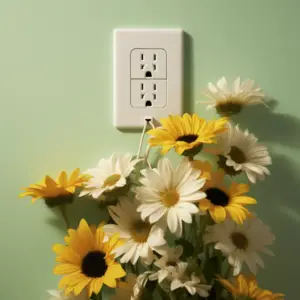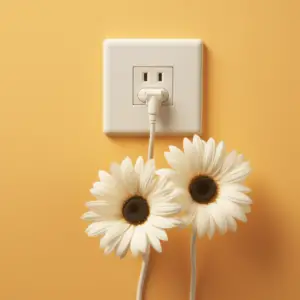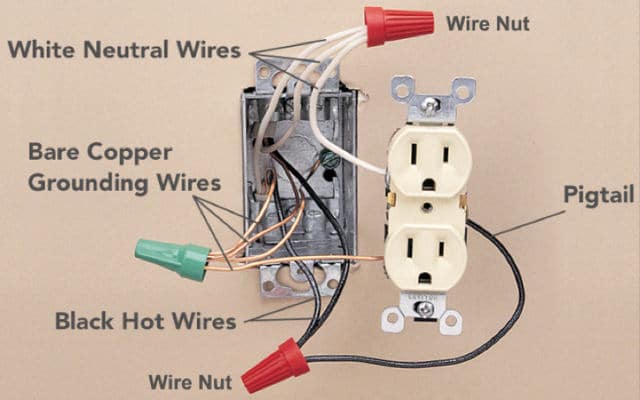There are two main methods of wiring up an electrical outlet. The first one is known as parallel wiring, and the other is a series wiring, commonly known as “daisy-chaining”.
Daisy-chaining an outlet simply means wiring receptacles in series with a single circuit. This method allows the user to use several outlets with a single circuit. It involves running the wire from outlets to outlets using the backstabbing or pigtails method.
Note that electrical outlets come with four terminals, two of which are brass and the other two are silver. They also have a green single terminal in the mix. These terminals allow you to daisy chain multiple outlets to a single circuit.
Individuals who want to have multiple outlets in a room tend to opt for this circuit system. Even though it outright violates the electrical code in some states, a lot of people still adopt this system. But is it good practice to daisy chain outlets for your home?
Table of Contents
Is it Safe to Daisy Chain Outlets?

Well, the answer to this question can be both yes and no depending on various factors. The fact that the process of daisy-chaining outlets involves installing multiple outlets on a circuit means that there’s an increased chance of overloading the circuit breaker, which could cause electrical accidents.
As a result, daisy-chained outlets are not considered a good option for your home. Electrical experts suggest that you avoid daisy-chaining more than two outlets to a single breaker.
Having multiple outlets connected to a single circuit can also be hazardous. In the event that the breaker blows, probably due to an overload, it will leave all other outlets dead.
It’s easy for one faulty outlet to affect others in a daisy-chained electrical system. This is one of the reasons why daisy-chaining goes against the code. If you’re considering implanting a daisy-chained circuit system, you better choose your device carefully.
It should be fine if all you’ve got is a bunch of low-power consuming devices. In addition to that, you should be well-informed about their requirements. Take your time and check out the power consumption rate of the devices.
A typical phone charger, for instance, draws about 5-20 watts of electricity. This obviously will scale higher for laptops that require about 100-300 watts.
Daisy-chaining can be safe provided the consumption rate doesn’t crash the capacity of the circuit. You might want to use GFCI outlets with other outlets, which can give indications concerning your outlet. So, we can say that daisy-chained outlets are safe provided you adhere to certain protocols. In any case, you should follow the electrical code set by the state where you live.
How To Reduce Safety Hazards of Daisy Chain Outlets
Circuits mostly used in the US often come in either 15 or 20 amps. This much amperage can range anywhere from 1800-2400 at 124V. To stay on the safe side, you should refrain from exceeding consumption past 1500W. Avoid pushing voltage usage to the maximum.
For high power-demanding devices, it’s best to rely on a dedicated circuit. Heaters, refrigerators, electrical dryers, etc. require heavy electricity consumption to operate. Never try to adopt a daisy-chained circuit system with them. One should always be careful when working with electrical appliances.
Keep an eye on the cords at the very beginning of the chain. Make sure you inspect it periodically to see if it gets slightly warm. If it does get warm, then it’s an indication that you’re probably forcing things. Every connection in the circuit system increases the resistance, which can cause the circuit to heat up.
What You Need To Know About Daisy Chain Outlets
First, you shouldn’t go for wiring the electrical outlets if you’re not an expert electrician. It’s recommended to hire a professional for such matters. Make sure to disconnect the power supply before handling the outlets and circuit breakers.
National Electrical Code (NEC) allows the wiring of 15 amp outlets with 14 gauges. That said, you should opt for 12-gauge wires to be on the safe side.
If you’re dead set on adopting a daisy-chained system you should go with the pigtails method. It is said to be the best practice for daisy-chaining receptacles, even though it involves extra labor.
The breakers, wires, and plugs should be used with the correct rating before chaining them with the circuit. You may want to wire multiple GFCI on one circuit because it can stop the other outlets from a power surge. Refrain from daisy-chaining more than two outlets to a single breaker.
Lastly, we suggest doing away with the idea of wiring your circuit with daisy-chaining outlets. Parallel wiring is safe and far more reliable for your circuit and devices. It renders a constant voltage to all the connected devices without compromising on safety or power supply.
The Final Word

Although daisy-chaining is a hazardous practice, one that authorities and electrical professionals frown upon, it is still quite common. A lot of people have so many electronic devices and appliances that the wall outlets in the average home or office cannot cater to all of them.
Overall, it is a popular practice, but the National Electrical Code and Occupational Safety and Health Administration prohibit it because it is dangerous and can cause electrical fires. It brings about too many loose ends.
Considering the wall outlet and the first power strip bear the load of all the appliances connected downstream, you’ll be running the risk of overloading your circuit and power strips.
It’s also worth mentioning that the more power strips you daisy-chain, the more resistance the current will experience, and the greater the voltage drop. Not to mention the heat generated.
The only effective technique to reduce the risks associated with the practice is to check that the total load of the devices you want to operate doesn’t exceed or overwhelm the capacity of the power strips of the wall outlet. Also, make sure the daisy-chain power strips are temporary.


